Omron exhibits new technologies in a virtual interactive platform
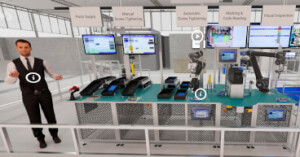 Omron has launched a virtual exhibition that enables visitors to walk through a 360 degree virtual tour, guiding them around ‘the factory of the future’ – one in which different innovations have been introduced to increase flexibility, enhance efficiency and boost productivity. The virtual exhibition highlights, in particular, six new technologies that can be used to achieve industrial transformation, with collaboration between people and machines taking a progressive leap forward.
Omron has launched a virtual exhibition that enables visitors to walk through a 360 degree virtual tour, guiding them around ‘the factory of the future’ – one in which different innovations have been introduced to increase flexibility, enhance efficiency and boost productivity. The virtual exhibition highlights, in particular, six new technologies that can be used to achieve industrial transformation, with collaboration between people and machines taking a progressive leap forward.
The solutions that are highlighted in the tour include all new robotics, vision and artificial intelligence (AI) technologies. These are all based around Omron’s ‘Innovative-Automation’ concept, which seeks to revitalise the manufacturing industry by enhancing cooperation and understanding between machines and people, using intelligent, integrated and interactive solutions.
Omron says the demonstrations show a leap forward in how people and machines can work together in a new type of harmony, by illustrating how manufacturing innovations can be put to practical use in collaborative production. Innovations such as those shown can be used to improve the lives of both factory workers and consumers, and contribute towards building a better society.
Among the exhibits, visitors are shown an intelligent High-Mix Low-Volume (HMLV) Cell Line Control System that combines AI with the Internet of Things (IoT) and 3D vision, intelligent sensing and control, and robotics, with the aim of optimising production and minimising errors.
Visitors will also experience 3D bin picking, which is used to automate complex picking operations during assembly. The tour continues with demonstrations of safe machine tending with cobots, AI inspection of potential defects in products, and the high-precision alignment of items. It concludes with a demonstration of laser machining technology, which can improve laser processing times by over 35%.
Fernando Colas, general director for marketing at Omron Europe, comments: “While many trade shows cannot take place in these difficult times, we wanted to bring our latest technology to customers in the virtual exhibition and give them the opportunity to experience the factory of the future online, wherever they are. This underlines the commitment of Omron to further advancing and promoting the future of productive manufacturing.”
Click here to visit the Omron virtual exhibition
Summary of exhibits
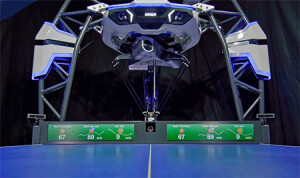 OMRON core technology ‘Sensing, Control + THINK!’ Machines bring out human potential and creativity, which in turn advances the ability of machines to deepen mutual understanding, thus adding new value that neither humans nor machines can create alone. Isn’t the conventional concept of robots (in other words, the concept of automation) having no emotion and simply repeating the determined tasks? However, these existing robots limit our response to flexible manufacturing going forwards.
OMRON core technology ‘Sensing, Control + THINK!’ Machines bring out human potential and creativity, which in turn advances the ability of machines to deepen mutual understanding, thus adding new value that neither humans nor machines can create alone. Isn’t the conventional concept of robots (in other words, the concept of automation) having no emotion and simply repeating the determined tasks? However, these existing robots limit our response to flexible manufacturing going forwards.
Omron has been integrating advanced control technologies such as AI, vision, and control, and is working to develop the ability of robots to change their move according to the surrounding situation and to extract human potentials. That is what FORPHEUS, ping-pong concept, is all about. It is possible to play with people according to the player’s returning ping-pong ball, and it is possible to give advice for the players to improve their ping-pong skill. This technology has been translated to manufacturing.
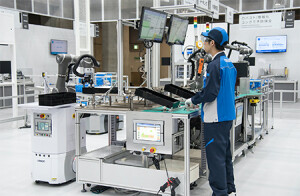 Cell Line Control System for HMLV manufacturers: With manufacturing facing issues such as rising labour costs, labour shortages, the aging of skilled engineers, the issue of technology transfer, and the improvement of productivity in variable-type and variable-quantity production, Omron has introduced an intelligent cell line control system.
Cell Line Control System for HMLV manufacturers: With manufacturing facing issues such as rising labour costs, labour shortages, the aging of skilled engineers, the issue of technology transfer, and the improvement of productivity in variable-type and variable-quantity production, Omron has introduced an intelligent cell line control system.
This HMLV solution is the reality where an intelligent cell line in which humans and machines collaborate, bring out the potential of humans and achieve the same quality and the same productivity anywhere in the world.
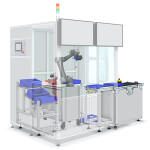 3D bin picking: Assembly machines often rely on humans in complex applications where large variety of objects need to be picked and placed. A robot would need to be equipped with eyes that can recognize multiple items, as well as calculate the needed force and movements to pick it up correctly.
3D bin picking: Assembly machines often rely on humans in complex applications where large variety of objects need to be picked and placed. A robot would need to be equipped with eyes that can recognize multiple items, as well as calculate the needed force and movements to pick it up correctly.
As a solution to these challenges, Omron has developed a very light, small-size 3D camera that can be mounted directly on the robot hand, along with smart vision algorithms. These tools are built on top of Omron’s vision system, so you can mix the new ones with the standard ones.
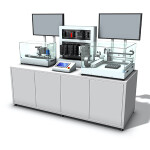 AI sensory inspection: Visual inspections that would have relied on the experience of skilled inspectors can now be automated by adopting Omron-unique AI technology. In this exhibit, Omron demonstrates the value of image processing in two examples.
AI sensory inspection: Visual inspections that would have relied on the experience of skilled inspectors can now be automated by adopting Omron-unique AI technology. In this exhibit, Omron demonstrates the value of image processing in two examples.
- AI Fine Matching – Extracts connector flaws and stably judges normal/abnormal. The stability of ‘AI Fine Matching’ is shown by comparing the AI with a conventional method, using the rate of over-detection that determines a normal product as abnormal.
- AI Scratch Detect Filter – Extracts scratches on metal surface. Achieves a quality of inspection that approaches the sensitivity of skilled inspectors.
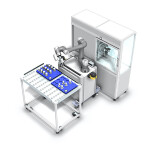 Safety fence-less machine tending: Until now, manufacturers have relied on workers for the supply and removal of parts to and from machine-tools. Due to the recent labour shortage in Japan and other countries, there is a growing demand for automation to supply and unload parts for machine-tools. However, in the case of automation using robots, safety fences are required and layout changes, including securing space, must be considered. Further, robot-adopted machine-tool automation has not been deployed as expected because the machine must be modified.
Safety fence-less machine tending: Until now, manufacturers have relied on workers for the supply and removal of parts to and from machine-tools. Due to the recent labour shortage in Japan and other countries, there is a growing demand for automation to supply and unload parts for machine-tools. However, in the case of automation using robots, safety fences are required and layout changes, including securing space, must be considered. Further, robot-adopted machine-tool automation has not been deployed as expected because the machine must be modified.
Omron provides optimal application by integrating collaborative robot, vision sensing and safety devices without changing layout of production floor and machines to achieve automation of machine-tending for machine-tools.
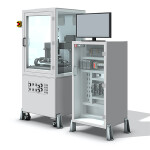 Non-stop and high precision alignment: Achieving shorter cycle time combining ‘on-the-fly control’ with trajectory motion control. Due to recent shortage of skilled engineers, production using general-purpose machines (that do not require design enhancement every time for higher accuracy) is required. With general-purpose machines, optimal operation may not be expected due to belt and chain stretching, chuck misalignment, and workpiece deformation, etc. For this reason, general-purpose machines are no longer able to provide the expected accuracy.
Non-stop and high precision alignment: Achieving shorter cycle time combining ‘on-the-fly control’ with trajectory motion control. Due to recent shortage of skilled engineers, production using general-purpose machines (that do not require design enhancement every time for higher accuracy) is required. With general-purpose machines, optimal operation may not be expected due to belt and chain stretching, chuck misalignment, and workpiece deformation, etc. For this reason, general-purpose machines are no longer able to provide the expected accuracy.
Omron provides high-precision positioning with mechanically low-accuracy machines by using ‘visual feedback’ technology that combines Omron-unique image processing and motion technologies.
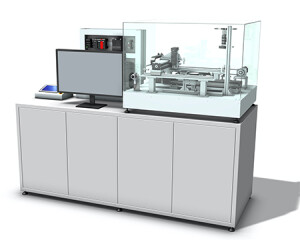 Ultra-high speed machining on the fly: In recent years, demand for electronic components has been increasing every day due to the up-take of smartphones and EVs. Laser processing, one of the production processes for electronic components, also needs to be evolved for higher processing time. In the conventional method, stage movement and galvanometer control are performed sequentially, that is, ‘step and repeat’ processing is performed. Moving and stopping are repeated and the machining speed is decreased. In addition, seams between parts occur, resulting in lower quality.
Ultra-high speed machining on the fly: In recent years, demand for electronic components has been increasing every day due to the up-take of smartphones and EVs. Laser processing, one of the production processes for electronic components, also needs to be evolved for higher processing time. In the conventional method, stage movement and galvanometer control are performed sequentially, that is, ‘step and repeat’ processing is performed. Moving and stopping are repeated and the machining speed is decreased. In addition, seams between parts occur, resulting in lower quality.
In order to provide high-speed laser processing, Omron has achieved continuous laser processing by consolidating control of all equipment into one controller. In comparison with conventional ‘step and repeat’, processing time has been shortened by about 35%.
Click here to visit the Omron virtual exhibition
Visit the Omron website for more information















